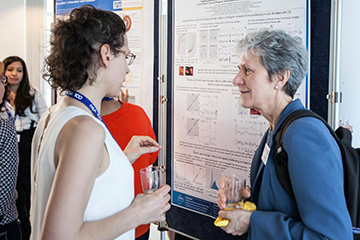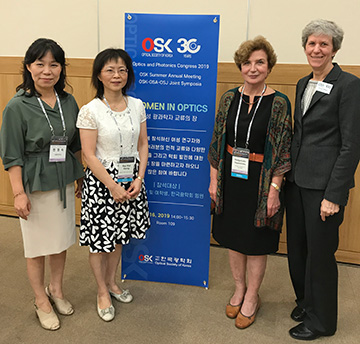
Deputy Scientific Director Leibniz IPHT Ute Neugebauer (left) with OSA President Ursula Gibson. [Image: Leibniz IPHT]
At September’s Frontiers in Optics + Laser Science conference, OPN had the opportunity to talk with 2019 OSA President Ursula Gibson of the Norwegian University of Science and Technology about her experience during her presidential term, and some of OSA’s recent efforts to boost the society’s diversity. The interview began with a question on the society’s core values—innovation, integrity, inclusivity and impact.
You devoted each of your first four “President’s Message” columns in OPN to one of OSA’s four core values. How have those values shaped your time as OSA President?
When you come into a position like this, you know what the organization is about; what it provides. I found that the core values do a great job of describing the mission of the organization, not in the “what we’re going to do” sense, but why we do it, and what the society stands for.
Let’s look at one of those core values in particular—inclusivity. In the wake of last year’s election, OSA is on track to meet a key goal—an equal number of men and women on its board of directors—in 2020. Why is that so important?
Well, consciously or unconsciously, people reflect the environment that they find themselves in. If you look around yourself in the world, you see equal numbers of men and women, but in the technical fields you don’t typically see that. So if you create an environment where you have equal numbers of technically oriented men and women, that normalizes it—normalizes something that really should be normal.
So we, in our role as board members, decided that we were going to create an environment where people could experience that. There are plenty of qualified women out there, and we’re going to include them. It’s a good decision.
What else have you found in your term that you think particularly reflects on OSA’s efforts in this area of diversity?
IONS and the summer schools are examples of opportunities for the society to ensure a mix of people in the programs. It’s all about making sure that we reach out, and include people from different countries, from different disciplines, from different genders, in all of the programs and services that OSA offers. Diversity is multidimensional.
I see OSA working really effectively to look at those multiple dimensions and include all of them. For young people, there is the possibility that they will get comfortable early enough that they will not need to adapt. And that, to me, is huge. [Note: for more on some of OSA’s initiatives to foster diversity in STEM, see www.osa.org/diversity.]

OSK Vice President Kyung Sook Hyun (left), OSA Fellow Ray-Hua Horng, OSA Member Malgorzata Kujawinska and OSA President Ursula Gibson. [Image: OSA]
What are some of the things you’ve tried to accomplish here during your presidential year, and some of the things that you found most satisfying about the experience?
I think the number-one thing I’ve tried to accomplish is making connections. Not for me personally, but reaching out as a representative of OSA, to young and diverse audiences and trying to strengthen the connections with other societies, with young students, with people from all over, and to establish OSA as a meaningful partner.
When I was running for this office, one of the things I mentioned in my candidate statement was that digital communication has really changed our day-to-day lives, and OSA has to be on top of that. What emerged was a harder look at the range of communication modalities that can be utilized. I got a wonderful group of people together who are also committed to this idea, and we have put forth some recommendations on how OSA can move to broaden the ways in which it communicates.
Connections and communication are both themes that I think about when I look back on what I have focused on accomplishing with this role. I’m not going to tell people what to do. But I do want to bring us together.
You have had a very multinational experience in your work—born in the U.K., a lot of academic and research work in the U.S., the past nearly ten years in Norway. How has that enriched your professional life?
Well, for one thing, because the environment has changed for me more than once, I feel that perhaps I’m less bound by the norms. When I first came to the U.S., I had a foreign accent and people noticed, and some people thought it was “cute.” So even though I was pretty young, I learned to adapt. Significant changes of context make you understand that you don’t have to be one particular flavor to be positive.
Moving to Norway was in some ways the biggest eye-opener. It made me appreciate more the struggles and challenges of people changing jobs and changing nations. Europe is complicated right now, and the rest of the world has been complicated for a long time. Direct interaction with those challenges was good for me and made me more embracing of the community.
You mentioned Europe. Could you comment on the impact of the society’s increased presence in Europe over the past year?
OSA has been, and will continue to be, a huge part of the optical presence in Europe. That said, the recognition that OSA doesn’t have to have just one headquarters is an important step. For the members, having locally based staff who are centered closer makes you feel more involved. Expanding so that different time zones are included—so that you can get hold of somebody who’s on your clock—is a great step, and I’ll be interested to see how it plays out.
How do current political complications, in Europe and elsewhere, affect science, and the ability of an organization like OSA to advocate in specific areas that cross national boundaries?
On a personal level, it’s easy for me to see that it’s complicated; I am allowed to work in Norway because I have a British passport, and with Brexit, the utility of that British passport is now in question.
And Brexit appears to be a sort of pushback against other people coming in—“other people” being defined however you want to. The feeling seems to be that if you’ve been there for 50 or 100 years you belong, and if not, you don’t. And that is so artificial, because most of us don’t have trajectory of 20 generations in one place. The complications that I see arising are people being reluctant to take jobs in certain locations because they feel that getting 'back' or moving on could be influenced by political factors.
Still, of all the people who are influenced by these movements, scientists are, possibly in a favored position. Within the scientific community, if you have acquired the training and made yourself useful through it, that will be recognized broadly, independent of background. And someplace like OSA—which brings people together as part of its mission—works to make sure that the young professionals in particular are connecting with people from different societies, from different countries.
So maybe we can influence the future accessibility for some segments and, more broadly, help tamp down rising nationalism. A scientific society cannot change society at large. But, with a focus on a core value of inclusivity, it can certainly influence the people who work in that area and try to broadly impact a wider audience. Because good sentiments can be spread as effectively as bad sentiments.

OSA President Ursula Gibson holds a sample of optical fiber in her office at the Norwegian University of Science and Technology. [Image: N. Bazilchuk/Norwegian Univ. of Sci. and Tech.]
What are the opportunities and challenges you’ve encountered being a president of a global organization?
This has been an opportunity to become more familiar with segments of the community that I had really not had major connections to before, and a fabulous opportunity to meet new colleagues and to reconnect with people from around the globe. My experience in Latin America was wonderful—going to the student-run conference there was a real eye-opener. And it’s been a great opportunity to learn from the people I’ve connected with. Not just to learn about their science, but to learn about the contexts in which they work, the challenges that they face and their own career trajectories.
Challenges? I think the fact that I now think my home is that little black thing there [points to carry-on suitcase] was a challenge! With a sabbatical in 2018, and less at-home time this year, I could do scheduled group meetings, but missed some of the casual student interactions I really enjoy. And it’s tough to adequately thank those who helped with the responsibilities on and off the road; it’s been an incredible privilege for me but there were many contributors.
